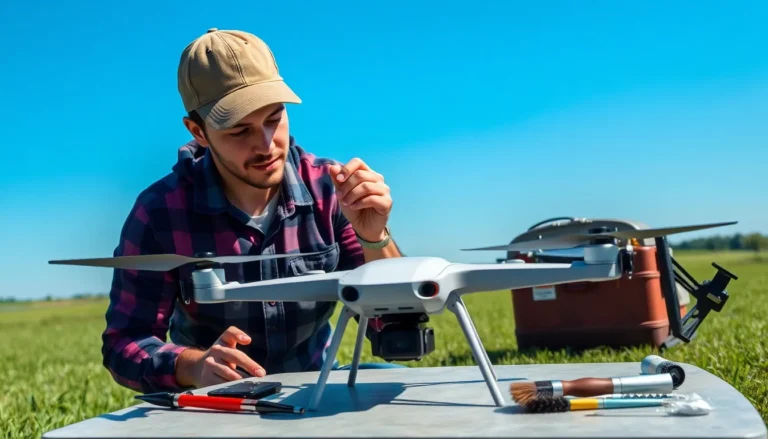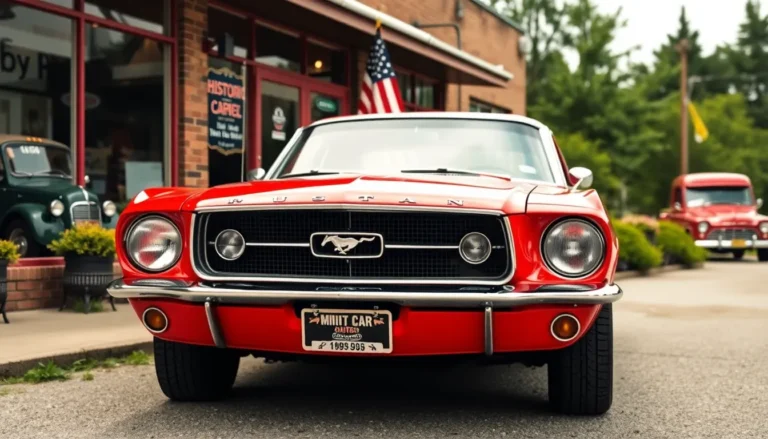In a world where flying has gone from the realm of dreams to a reality, FPV drones are taking the skies by storm. Imagine zooming through the air at breakneck speed, dodging trees like a pro while wearing goggles that make you feel like a superhero. It’s not just a hobby; it’s a thrilling adventure waiting to be explored.
Whether you’re a seasoned pilot or a curious newbie, FPV drones offer an exhilarating escape from the mundane. They’re not just high-tech toys; they’re gateways to stunning aerial views and heart-pounding races. So buckle up, because the world of FPV drones is about to take you on a wild ride that’s as entertaining as it is breathtaking. Who knew flying could be this much fun?
Table of Contents
ToggleOverview of FPV Drones
FPV drones represent a blend of advanced technology and exhilarating flight experiences. These drones equip pilots with a unique perspective, allowing them to see exactly what the drone sees in real-time. Pilots wear specialized goggles that provide a live video feed, enhancing the immersion of the flight experience.
Manufacturers design FPV drones for various applications, from racing to aerial photography. Racing drones prioritize speed and agility, often featuring lightweight materials and powerful motors. On the other hand, photography drones focus on stability and camera quality. This variety caters to diverse interests within the drone community.
Experiencing FPV flying involves learning essential skills. Pilots must master controls, understand flight dynamics, and adapt to changing conditions. Many online communities and resources offer tutorials and tips, making it easier for newcomers to enter the hobby.
Safety remains a critical aspect of operating FPV drones. Users should always follow local regulations and guidelines to ensure a safe flying environment. An understanding of airspace restrictions and maintaining line of sight are fundamental for responsible pilots.
FPV drones promote creativity and innovation. Enthusiasts often customize their drones, enhancing performance and aesthetics. The potential for personalization encourages a hands-on approach, allowing pilots to tailor their experience to their preferences.
In competitions and events, FPV drones showcase remarkable skills and technology. Participants engage in thrilling races that challenge speed and precision, while others display aerial maneuvers that highlight piloting talent. Such events foster a sense of community among FPV pilots, elevating the overall experience of flying these extraordinary machines.
Types of FPV Drones

FPV drones come in various types, each designed for specific uses. Understanding these differences helps pilots choose the right equipment for their needs.
Racing Drones
Racing drones excel in speed and agility, crafted for competitive environments. Lightweight frames and high-performance motors allow for rapid maneuvers. Racing pilots often prefer custom builds, optimizing their drones for specific tracks. These drones typically feature streamlined designs, minimizing drag. Advanced pilots utilize features like electronic speed controllers for enhanced responsiveness.
Freestyle Drones
Freestyle drones offer flexibility and artistic expression during flight. Pilots use these drones to perform tricks, flips, and acrobatics in the air. Durable frames accommodate crashes, allowing for more adventurous flying. Powerful motors contribute to superior thrust and responsiveness. Freestyle enthusiasts often customize tuning settings for better control and performance.
Camera Drones
Camera drones cater to those seeking stunning aerial photography and videography. Equipped with high-quality cameras, these drones capture impressive footage. Stability features, like gimbals, ensure smooth video while flying. Pilots utilize camera drones for various applications, including real estate, events, and nature filming. Additionally, many models support live streaming, allowing instant sharing of breathtaking views.
Components of FPV Drones
FPV drones consist of several critical components that work together to provide an immersive flying experience. Understanding these elements is essential for both novice and experienced pilots.
Flight Controllers
Flight controllers act as the brain of the FPV drone. They process data from various sensors, adjusting the drone’s movements in real time. A flight controller features built-in stabilization systems to ensure smooth operation, making it easier to maneuver. Popular models include Betaflight and KISS, known for their user-friendly interfaces and customizable settings. Upgrading a flight controller can enhance overall performance, offering improved responsiveness and adaptability in different flying conditions.
Video Transmitters
Video transmitters enable real-time video streaming from the drone to the pilot’s goggles. They transmit high-definition footage, allowing pilots to navigate through a first-person perspective. Typically, video transmitters vary in power output measured in milliwatts, ranging from 25mW for short-range flights to 800mW for long-range adventures. Choosing the right video transmitter affects video quality and signal range, crucial for maintaining a steady connection during flight. A common choice among pilots is the TBS Unify Pro, known for its reliability and performance.
Cameras
Cameras play a pivotal role in capturing stunning aerial footage and delivering high-quality visuals to pilots. FPV drones often feature lightweight cameras designed for minimal drag while providing excellent video quality. Popular camera options include the RunCam and Foxeer, known for their low-light performance and durability. Mounting the camera correctly is vital for optimal viewing angles, providing a true first-person flying experience. Pilots often customize camera settings for bolder colors and sharper images, enhancing the overall viewing experience.
Benefits of Using FPV Drones
FPV drones offer unique advantages that enhance the flying experience and broaden the range of uses.
Enhanced Aerial Perspective
With FPV drones, pilots achieve an immersive aerial perspective. This experience allows users to view landscapes from vantage points that traditional drones miss. Adjustments in height and angle become intuitive, enabling stunning captures of scenery. Enthusiasts often appreciate how this perspective transforms ordinary views into breathtaking visual narratives. Furthermore, pilots can explore hard-to-reach locations without physically being there. Capturing professional-quality images and videos becomes more accessible thanks to refined control and stability features. These drones also facilitate creative expression as pilots maneuver through complex environments.
Real-Time Engagement
Real-time engagement greatly enhances the thrill of flying FPV drones. Instant video feeds directly from the drone to the pilot’s goggles create an exhilarating sense of presence in the air. This connection significantly increases the pilot’s responsiveness during flight. Masters of drone racing highlight how this immediacy aids in executing complex maneuvers with precision. Enthusiasts enjoy the interactive nature of controlling the drone, making each flight an engaging experience. Pilots often experience a surge of adrenaline, feeling like they soar with the drone. Community events, such as races and freestyle competitions, emphasize this dynamic interaction, fostering camaraderie among pilots.
Challenges with FPV Drones
FPV drones present various challenges that enthusiasts encounter while pursuing their passion. Understanding these obstacles is essential for a safe and enjoyable experience.
Regulatory Concerns
Regulatory concerns significantly affect the operation of FPV drones. Local laws often dictate where and how these drones can fly, with restrictions on altitude and proximity to populated areas. Pilots must remain aware of airspace classifications and no-fly zones, as violations can lead to legal consequences. Organizations like the Federal Aviation Administration (FAA) provide guidelines for recreational and commercial use, emphasizing the necessity of obtaining proper registrations. Staying informed about updates to regulations ensures compliance, helping pilots avoid issues during flights.
Technical Limitations
Technical limitations can hinder the performance of FPV drones. Signal interference often occurs due to environmental factors, affecting video quality and drone control. Battery life remains a significant limitation, as flying times usually range from 5 to 30 minutes, depending on the drone model and usage. Additionally, weight considerations impact flight performance; heavier drones may struggle with agility and speed. Pilots often face challenges with technical setups, requiring knowledge about components like video transmitters, cameras, and flight controllers. Effective troubleshooting skills and regular maintenance help mitigate these technical issues and enhance the flying experience.
FPV drones offer an exhilarating blend of technology and adventure that captivates both seasoned pilots and newcomers alike. With the ability to experience flight from a first-person perspective, enthusiasts can immerse themselves in stunning aerial views and thrilling maneuvers.
As the FPV community continues to grow, so does the innovation behind these remarkable machines. Pilots are encouraged to explore various types of drones to find the perfect fit for their interests, whether it’s racing, freestyle flying, or aerial photography.
While challenges such as regulatory compliance and technical limitations exist, the rewards of flying FPV drones far outweigh the obstacles. Engaging in this dynamic hobby not only enhances personal skills but also fosters a sense of community among fellow pilots, making every flight an unforgettable experience.










